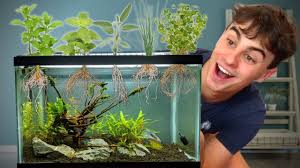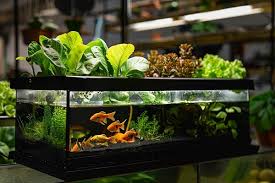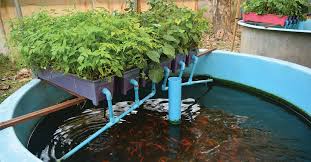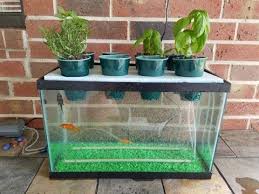Aquaponics is an innovative and sustainable farming method that combines aquaculture (the cultivation of fish) with hydroponics (growing plants in water without soil). This system creates a symbiotic environment where fish and plants benefit from each other, leading to increased productivity and reduced resource consumption.
As global populations rise and environmental concerns become more pressing, aquaponics offers a promising solution to food production challenges. With its potential to produce fresh fish and vegetables in a compact space, it is gaining popularity among urban farmers, home gardeners, and commercial growers alike.
Setting up an aquaponics fish tank is the first step toward creating a thriving aquaponic system. The fish tank serves as the foundation of the setup, providing a habitat for fish while also supplying nutrient-rich water for the plants. Choosing the right fish species is crucial, as different species have varying requirements for temperature, pH levels, and space. Common choices include tilapia, catfish, and goldfish, all of which are hardy and well-suited for aquaponics systems.
The fish tank must be adequately sized to accommodate the number of fish being raised and to maintain optimal water quality. A larger tank helps stabilize water parameters, making it easier to manage the ecosystem. Additionally, installing a filtration system is essential for keeping the water clean and healthy for both fish and plants. This filtration system usually consists of a mechanical filter, which removes solid waste, and a biological filter, which converts harmful ammonia produced by the fish into nitrates that plants can utilize.
Temperature control is another vital aspect of the aquaponics fish tank setup. Fish thrive within specific temperature ranges, typically between 70°F and 85°F (21°C to 29°C). Therefore, using heaters or chillers can help maintain stable water temperatures, promoting fish health and growth. Regular monitoring of water parameters, such as pH, ammonia, nitrite, and nitrate levels, is crucial for the success of the system. A pH level of 6.8 to 7.4 is generally ideal for most aquaponic fish species.
Once the fish tank is set up and the water conditions are optimal, it’s time to introduce the fish. Before doing so, it’s essential to cycle the tank to establish beneficial bacteria that will help break down waste products. This process can take a few weeks but is vital for creating a stable environment. Introducing fish gradually can also help prevent sudden spikes in ammonia levels, which can be harmful.
In addition to the fish tank, the aquaponics system will require a grow bed where plants will be cultivated. The grow bed can be set above or beside the fish tank, allowing gravity to facilitate water flow. Various growing media can be used in the grow bed, such as gravel, clay pellets, or rock wool, to support plant roots and facilitate water retention.
In conclusion, setting up an aquaponics fish tank is the foundational step in creating a productive and sustainable aquaponics system. By carefully selecting fish species, monitoring water quality, and integrating the fish tank with a grow bed, you can establish a balanced ecosystem that benefits both fish and plants, paving the way for a successful aquaponics venture.
Understanding the Aquaponics System
1. Definition: Aquaponics combines aquaculture (raising fish) with hydroponics (growing plants without soil), where fish waste provides nutrients for plants, and plants purify the water for fish.
2. Components: An aquaponics system includes a fish tank (for raising fish), a grow bed (for cultivating plants), a pump system (to circulate water), a filtration system (to remove solids), and an aeration system (to provide oxygen).
3. Nutrient Cycle: Fish produce waste rich in ammonia, which beneficial bacteria convert into nitrites and then nitrates, serving as nutrients for plants; the plants filter the water, which returns to the fish tank.
4. Benefits: Aquaponics uses less water, reduces chemical fertilizer needs, enables year-round production, and allows for efficient space use by growing both fish and vegetables.
Choosing the Right Fish for Your Tank

1. Compatibility: Select species like tilapia (hardy and fast-growing), catfish (adaptable), or trout (requires cooler water) that thrive together and with your plants.
2. Climate Adaptability: Consider local climate and water temperature; tilapia is suitable for warmer climates, while trout is best for cooler conditions.
3. Growth Rate and Size: Choose fish that grow quickly and fit your tank size; fast-growing species allow for more frequent harvesting.
4. Diet and Feeding Habits: Understand dietary needs; some fish require specialized feed while others can thrive on general diets.
5. Local Regulations: Check regulations on fish farming in your area, as certain species may need permits or have restrictions.
Selecting the Tank Size and Material
1. Tank Size: Calculate required volume based on fish; provide about 1 gallon of water per inch of fish and balance with the size of the grow bed for nutrient availability.
2. Tank Material: Options include plastic (lightweight, food-safe), fiberglass (durable for larger setups), or metal (requires special coatings to prevent rust).
3. Shape and Depth: Round tanks promote better water circulation, while rectangular tanks maximize surface area; depth affects water capacity and aeration needs.
Setting Up the Tank Location
1. Indoor vs. Outdoor: Choose between an indoor setup (better control over conditions) or an outdoor setup (benefits from natural sunlight).
2. Sunlight Exposure: Ensure adequate sunlight (6-8 hours daily) for plant growth; consider grow lights for insufficient natural light.
3. Accessibility: Set up in an easily accessible location for maintenance, harvesting, and feeding fish.
4. Water Source: Ensure a reliable nearby water source for filling and maintaining the tank; water quality is crucial for fish and plants.
5. Drainage and Leveling: Ensure a well-drained area to prevent flooding; keep the tank level for proper circulation and stability.
Installation of Filtration and Aeration Systems
1. Filtration Types: Install mechanical filters (to remove solid waste), biological filters (to promote beneficial bacteria growth), and chemical filters (to eliminate toxins) for effective water purification.
2. Pump System: Choose a suitable pump that can handle the tank volume and ensure consistent water flow; consider submersible or inline pumps based on your setup.
3. Aeration: Incorporate air stones or diffusers to introduce oxygen into the water; proper aeration supports fish health and enhances beneficial bacteria activity.
4. System Configuration: Position filters and pumps to ensure effective water circulation; water should flow from the fish tank to the filtration system before reaching the grow beds.
Read Also: Poultry Disease Prevention and Management
Adding Substrate and Aquatic Plants

1. Substrate Selection: Choose an inert growing medium (like expanded clay pellets, gravel, or rock wool) that provides stability for plants and allows water to circulate freely.
2. Plant Selection: Opt for fast-growing plants like lettuce, herbs, or kale that can thrive in an aquaponics system; consider the growth habits and space requirements of each plant.
3. Planting Technique: Place plants into the substrate, ensuring roots have good contact with the medium; avoid overcrowding to promote healthy growth.
4. Aquatic Plants: Include floating plants like water hyacinth or duckweed to improve water quality and provide shade; these plants can help reduce algae growth and enhance nutrient uptake.
Cycling the Tank for Optimal Conditions
1. Cycling Process: Establish beneficial bacteria by cycling the tank; this process converts ammonia from fish waste into nitrites and then nitrates, making it safe for plants.
2. Duration: Allow 4 to 6 weeks for the cycling process; monitor ammonia, nitrite, and nitrate levels during this period to ensure bacteria establishment.
3. Testing: Use water test kits to check parameters; ideally, ammonia should be near 0 ppm, nitrites should also be 0 ppm, and nitrates should be present to support plant growth.
4. Adding Fish: Once the tank is cycled, gradually introduce fish to avoid overwhelming the system; start with a small number and increase as the system stabilizes.
Monitoring Water Quality Parameters
1. Key Parameters: Regularly monitor pH (ideal range: 6.0-7.5), ammonia (should be 0 ppm), nitrites (should be 0 ppm), and nitrates (aim for 5-100 ppm depending on plant needs).
2. Temperature Checks: Maintain water temperature appropriate for your fish species (typically 68-80°F for tilapia); use heaters or chillers as necessary.
3. Dissolved Oxygen Levels: Ensure sufficient dissolved oxygen (ideally 5-8 mg/L) for fish and bacteria; aeration systems can help maintain these levels.
4. Regular Testing: Conduct water tests weekly or bi-weekly; track results over time to identify trends or issues and make necessary adjustments promptly.
Read Also: The Ideal Instrument for Debeaking the Birds
Feeding and Caring for Your Fish

1. Fish Diet: Provide a balanced diet suitable for your fish species; use high-quality commercial fish feed that meets their nutritional needs (protein, fats, vitamins).
2. Feeding Schedule: Establish a regular feeding routine, typically 1-2 times a day; monitor how much your fish consume to prevent overfeeding, which can lead to water quality issues.
3. Portion Control: Feed only what your fish can eat in 5-10 minutes; excess food can decay in the tank, increasing ammonia levels and harming fish health.
4. Observation: Regularly observe fish behavior and appearance; look for signs of illness or stress (like lethargy or abnormal swimming) to address potential health issues early.
Check For Common Issues
1. Water Quality Problems: Check for high ammonia or nitrite levels; perform partial water changes and check filtration systems to resolve these issues.
2. Fish Health Issues: Identify symptoms such as discoloration, lesions, or abnormal swimming; consult resources or professionals to diagnose and treat any diseases or parasites.
3. Plant Growth Problems: Monitor plant health for signs of nutrient deficiencies (yellowing leaves or stunted growth); adjust nutrient solutions or check for pH imbalances as needed.
4. System Failures: Regularly inspect equipment like pumps and filters for proper operation; have backup systems in place or spare parts to quickly address any failures.
Maintaining Your Aquaponics System
1. Regular Cleaning: Clean filters, tanks, and grow beds periodically to prevent clogs and maintain water quality; remove debris and waste from the system.
2. Water Level Checks: Regularly monitor water levels in the tank and grow beds; top up as needed to ensure adequate water circulation and fish health.
3. Nutrient Management: Continuously check and adjust nutrient levels based on plant needs; replenish nutrient solutions and maintain a balanced pH for optimal growth.
4. System Monitoring: Keep detailed records of water quality parameters, fish health, and plant growth; use this data to identify trends, plan maintenance, and optimize system performance.
Do you have any questions, suggestions, or contributions? If so, please feel free to use the comment box below to share your thoughts. We also encourage you to kindly share this information with others who might benefit from it. Since we can’t reach everyone at once, we truly appreciate your help in spreading the word. Thank you so much for your support and for sharing!
Read Also: Importance and Need for Financial Literacy (Financial Education)






